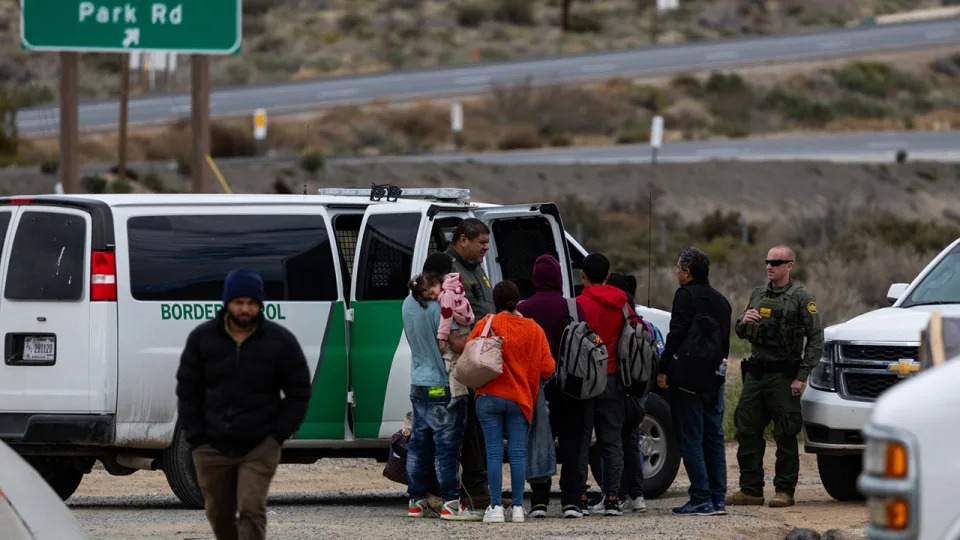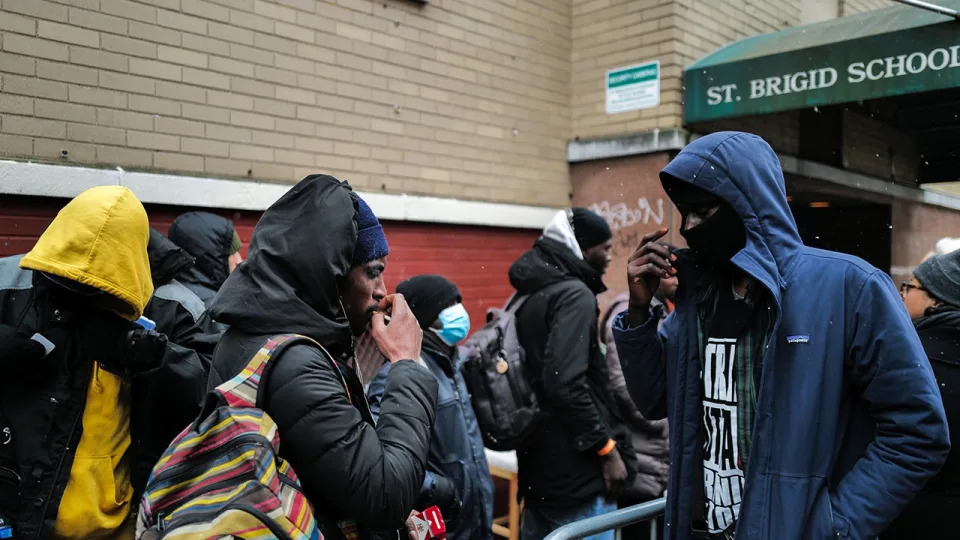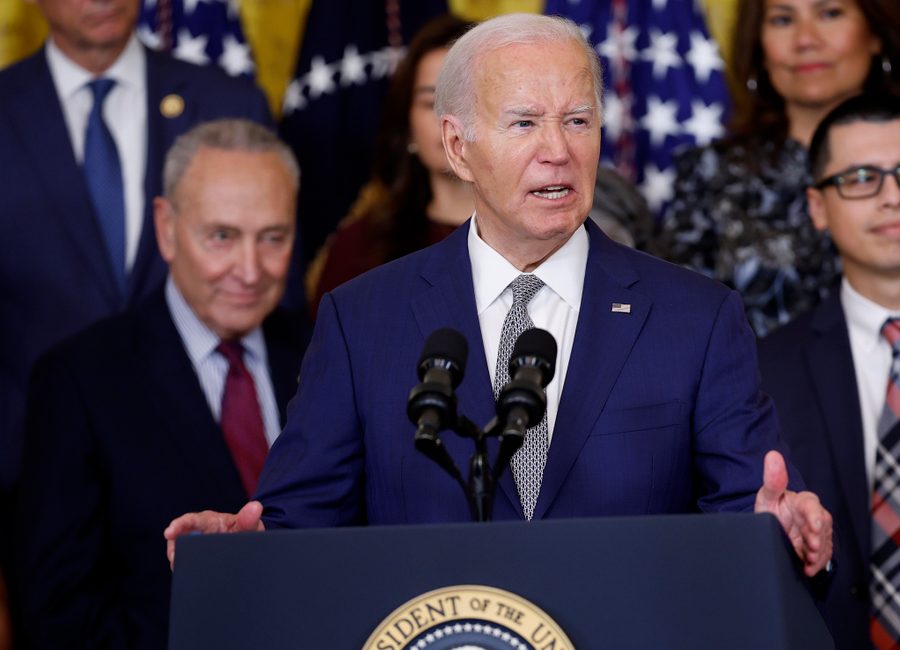Wed, January 20, 2021

President Joe Biden is offering foreign-born farm workers the chance to immediately apply for permanent residency.
Biden's immigration proposal would also give agriculture industry workers the right to overtime pay.
Each year, over 200,000 temporary agricultural workers come to the United States.
President Joe Biden is presenting a sweeping immigration reform bill to Congress on his first day in office, prioritizing a sharp rebuke to the Trump years. It would award permanent residency to farm workers who have kept the country fed throughout the pandemic, offer a pathway to citizenship for Dreamers - giving hope to one son of farm workers and brother of a Dreamer.
Those who receive green cards would also be fast-tracked for citizenship, part of an effort to provide a path to legal status for more than 11 million undocumented people currently in the US.
The bill, which Biden is introducing within hours of his inauguration, will also incorporate the central feature of legislation that Vice President-elect Kamala Harris introduced as a senator, extending overtime pay to all who toil in the agriculture industry.
"This bill is fundamentally different than what any other president has ever done in emancipating farm workers so they can escape pervasive fear and behave like free men and women," United Farm Workers President Teresa Romero, a member of Biden's transition team, said in a statement.
As The Washington Post reported on Tuesday, the "centerpiece" of the Biden administration plan is an eight-year path to citizenship for millions of undocumented Americans, providing them temporary status for five years and then a green card for three; those who pass a background check and pay their taxes would ultimately receive citizenship.
In addition to farm workers, those brought to the United States as children, as well as adults who fled natural and human disasters in Central America and elsewhere, would also be eligible to immediately receive permanent residency.
Biden is also poised to issue a slew of executive orders reversing his predecessor's more controversial policies, such as the de facto "Muslim ban" prohibiting travelers from countries such as Iran, Iraq, Libya, and Somalia. The Post reported that he is also likely to reinstate a program providing temporary legal status to minors from Central America.
The real-world impact of Biden's proposal, should it become law
Ruben, an 18-year-old college student in Washington, is one of five children born to farm workers who came to the US from Mexico (Insider is withholding his last name due to parents' undocumented status). He spent summers picking apples and blueberries - backbreaking work that has led him to pursue a career in medicine.
He's relieved that the Trump era is over. Former President Barack Obama may have deported millions, but Ruben said he did not demonize and instill fear in millions quite like his successor did, "stereotyping Latino immigrants and just yelling out whatever he thought."
"My grandma was here and she would watch the news every day, "Ruben said, "and she would just panic. We just told her to stop watching."
Ruben campaigned for Biden, spending over a month in Arizona knocking doors in a state where the Latino vote delivered a knockout to Trump's hopes for a second term. He's hopeful that the stress of the last four years can give way to some optimism, purchased with his contribution to getting out the vote. For him, there's the chance that his family, including an older brother who is a DACA recipient, could stop living in fear.
His parents, however, in the US since 2001, have lived through two rounds of presidents pledging to make the immigration system a little more humane. Still, Biden's proposal, the most liberal in decades - with two houses of Congress to clear before becoming law - is to them no less than a potential godsend.
"They're kind of shocked," Ruben said. "They're pretty religious, so they just have faith in God that this one's going to pass."
Read the original article on Business Insider
Jasmine Aguilera, TIME
Wed, January 20, 2021

Migrants, who arrived in caravan from Honduras to try to make their way to the United States, wait at the border in Vado Hondo, Guatemala, on January 18, 2021. Credit - Photo by Luis Vargas/Anadolu Agency via Getty Images
On his first day in office, President Joe Biden sent an immigration bill to Congress filled with goals that are a far cry from the Trump Administration’s hardline policies. Along with proposals for a pathway to citizenship for undocumented immigrants who meet certain qualifications, Biden’s bill plans to address the deeper goal of addressing the root causes of migration, particularly from Central America. However, while it is a loftier in its aims in how to tackle immigration, experts say that it will take a lot more than is being proposed to address the issues that cause immigration from the region.
Biden’s bill comes after a caravan of thousands of Honduran migrants heading north to the U.S. was dissipated by Guatemalan security forces. Biden Administration officials warned migrants not to make the journey to the U.S., but experts believe people from Honduras, El Salvador and Guatemala will keep attempting to migrate to safer locations such as the U.S. as they have in recent years because of the dire situations they continue to face in their home countries.
Through the U.S. Citizenship Act of 2021, Biden has put forth a $4 billion four-year plan that aims to decrease violence, corruption and poverty in El Salvador, Guatemala and Honduras, the home countries of many of the migrants who have arrived at the U.S.-Mexico border to seek asylum in recent years. The bill would also establish centers throughout Central America for people to pursue refugee resettlement in either the U.S. or other countries.
Though the $4 billion is an increase in investment compared to the Trump and Obama Administrations, Ariel Ruiz Soto, a policy analyst at the Migration Policy Institute, says that $4 billion over the course of four years alone will not be enough to tackle the underlying issues. Investment from the U.S. needs to coincide with partnerships with the governments of Central American countries and Mexico, he says, and include special attention to education and jobs for youth, not just emphasis on security and enforcement measures, as was done under Trump and Obama. Improving economies could allow for people to have a stable future in their home countries, causing migration to decrease in the long run, possibly decades from now.
“[$4 billion] is an upgrade, and it will have significant consequences,” Ruiz tells TIME. “But it is only going to be effective if it’s sustainable over decades…it can’t be just four years, it can’t be eight years, it has to be sustained.”
It’s also an effort the U.S. should not undertake alone, Ruiz adds. Mexican President Andrés Manuel López Obrador also supports investing in Central America. López Obrador has worked with the U.S. and Canada on similar efforts made to address the root causes of migration in Central America, and in 2018 the U.S. backed Mexico by investing $5.8 billion. However, much of that money was already previously committed, according to The New York Times. “The United States by no means needs to be the only one doing this work,” Ruiz says. “What will make it more successful is if Mexico and the U.S. are speaking with the same voice about investment in the region.”
Any plan for investment should also cater to the specific needs of each country, Ruiz says. For example, 47% of Guatemalan children under the age of five suffer from chronic malnutrition according to the World Bank, and Guatemala ranks ninth in the world for level of risk to the effects of climate change, meanwhile in Honduras, 48% of people live in poverty and there is a high level of violence.
Investment by the U.S. and Mexico also means engaging with the private sector to create job opportunities in the Northern Triangle, Ruiz adds.
“Now that the new president (Biden) is here we are waiting for the answer, all of us immigrants who are here from Honduras,” one Honduran man, 18-year-old Eber Sosa who was in the caravan this week, told the Associated Press. “We are looking to see what the new president says to move forward.”
Violence continues to be high in Honduras and El Salvador, though homicide rates have been decreasing steadily, and Guatemalans face high unemployment, poverty and malnutrition. Hondurans were particularly devastated by hurricanes Eta and Iota in November. The three countries have also suffered economically as a result of COVID-19.
Ian Kysel, visiting assistant clinical professor of law at Cornell Law School and co-director of the Asylum and Convention Against Torture Appellate Clinic, says he sees this effort by Biden as a first step in creating a regional immigration policy grounded in human rights. “Going back decades, the U.S. Government has failed to adequately invest in making rights and human dignity the cornerstone of U.S. policy in the region—on migration or otherwise,” he tells TIME in a statement. “Human rights are key to addressing the major challenges facing migration. Past administrations have heavily invested in deterrence and securitization, forcefully externalizing the U.S. border to the detriment even to those seeking protection from persecution.”
But whether $4 billion does end up being allocated to Central America depends on Congress. On Wednesday, U.S. Senator Bob Menendez, a Democrat from New Jersey, announced he would be the one to introduce Biden’s bill. Menendez was one of the so-called “Gang of Eight” Senators who led the push for comprehensive immigration reform in 2013, an effort by former President Barack Obama to provide a pathway to citizenship for undocumented immigrants that ultimately failed in the House.
What to know about Joe Biden's pathway
to citizenship immigration plan
President-elect Joe Biden will send to Congress an extensive immigration reform bill that includes an eight-year pathway to citizenship on Wednesday, following through on a long-standing campaign pledge to move on immigration on day one of a Biden presidency.
The new details of Biden’s legislation were first reported by The Washington Post, and confirmed by Biden transition officials.
Biden will send to Congress on Wednesday a policy that will include an eight-year pathway to citizenship for immigrants without legal status, and expand admissions for refugees to the country.
He would also take a different approach from the Trump administration’s border wall for enforcement, investing in technology at the border instead.
Biden, who worked as vice president on addressing the root causes of migration from Central American countries, will seek to do the same with his new legislation, the officials confirmed.
The plan tracks closely with the approach to immigration Biden discussed on the campaign trail, but expands on how Biden will structure the comprehensive overhaul.
MORE: Trump's immigration legacy: A border wall Biden vows to freeze
For those living in the U.S. without legal status as of Jan. 1, Biden’s planned pathway would allow for five years of temporary status, and the opportunity to earn a green card upon meeting requirements like paying taxes, and passing a background check. Eligibility to apply for citizenship would follow three years later.
Vice President-elect Kamala Harris also spoke about the policy in a recent interview, previewing the eight-year pathway to citizenship, along with expanding protections for DREAMers and DACA recipients.
“These are some of the things that we're going to do on our immigration bill, and we believe it is a smarter and a more humane way of approaching immigration,” said Harris in an interview with Univision last week.
MORE: Trump-Biden transition live updates: Trump unlikely to issue pardons for self, family
Biden had long previewed his plan to send a bill overhauling the immigration system to Congress on the first day of his administration -- a significant move that places a priority on addressing the issue that the Obama administration was criticized for during their time in office.
“[W]e made a mistake. It took too long to get it right,” Biden said of the Obama Administration's record on immigration, during the Oct. 23 presidential debate.
While Democrats will hold a slim majority in both chambers in Congress during the start of Biden’s presidency, the proposal would still need to earn support from some Republicans in the Senate to pass into law -- testing Biden’s campaign trail pitch that he could garner bipartisan support for his legislative efforts as president.
Biden’s immigration push will be introduced as the country continues to grapple with the COVID-19 pandemic, and added to the ambitious legislative efforts Biden’s administration is already undertaking to get a handle on the virus.
MORE:Biden seeks early momentum on COVID and more: The Note
Biden unveiled a nearly $2 trillion COVID rescue plan last week to offer immediate relief to families struggling amid the continued economic downturn due to COVID.
Introducing the legislation is just one part of the aggressive start Biden is planning for the beginning of his administration. Over his first 10 days in office, Biden also plans to take executive action on a number of additional policy issues, including climate change, racial inequality and criminal justice reform.
On Inauguration Day alone, Biden will sign executive orders on extending the existing pause on student loan payments and interest, re-join the Paris Climate Agreement, and reverse the Trump administration’s travel “ban” on predominantly Muslim countries, in addition to putting in place a mask mandate on federal property amid the COVID-19 pandemic.
What to know about Joe Biden's pathway to citizenship immigration plan originally appeared on abcnews.go.com




















